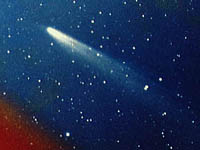|
|

|
|
Comet
Kohoutek was visible to the naked eye from the end of Nov. 1973 until
late Jan. 1974. Initially touted as the "Comet of the Century," it
put on what was considered a disappointing display. Photo: NASA. [
Click
for a larger image
.]
|
![]() n
the heels of this sensational announcement, a firestorm erupted in the
press (no doubt delighting the makers of two Hollywood movies about killer
asteroids and comets due out later in the year). But the announcement
also prompted Eleanor Helin and her colleagues at the Jet Propulsion Lab
to search their database of images. Within a day, the JPL team found photographs
of 1977 XF11 dating from 1990. This allowed astronomers to recalculate
the asteroids orbit and announce that it would pass at a comfortable distance
from the earth—about 500,000 miles, or twice the distance to the
moon.
n
the heels of this sensational announcement, a firestorm erupted in the
press (no doubt delighting the makers of two Hollywood movies about killer
asteroids and comets due out later in the year). But the announcement
also prompted Eleanor Helin and her colleagues at the Jet Propulsion Lab
to search their database of images. Within a day, the JPL team found photographs
of 1977 XF11 dating from 1990. This allowed astronomers to recalculate
the asteroids orbit and announce that it would pass at a comfortable distance
from the earth—about 500,000 miles, or twice the distance to the
moon.
Is this a case of science gone wrong? Not at all, according to most astronomers. If Marsden hadn't shared his initial prediction with the rest of the scientific community, the JPL folks would have had no reason to look for the asteroid in their records. Perhaps the only mistake was in immediately announcing the finding to the public. But astronomers are, for the most part, open with their data. The most glaring error of the movies Deep Impact —about a planet-killing comet —and Armageddon —whose villain is an asteroid "the size of Texas"—is the ease with which the government and the scientific community keep the probability of a global catastrophe secret. For one thing, there are all those students and backyard astronomers constantly watching the skies. To date, about 20 percent of asteroids have been discovered by amateurs.

How often do large objects hit the earth? Eleanor F. Helin explains that while globe-threatening impacts come only once in tens of millions of years, locally catastrophic impacts can happen several times each century on earth. |
|
![]()
Despite what happens in the Hollywood movies, the chances of a globe-threatening
asteroid or comet hitting the earth are increasingly small. But not impossible.
Evidence suggests that 65 million years ago the earth was walloped by
a ten-mile-wide meteorite. A layer of iridium, an element that's rare
on the earth's surface but common in some asteroids, left a fingerprint
in the geologic record at about the same time the dinosaurs disappeared
from the planet. Scientists have found what they think is the impact site
along the Yucatán Peninsula of Mexico, a circular hole over a hundred
miles wide that's now buried by sedimentary rock.
|
|
|
|
